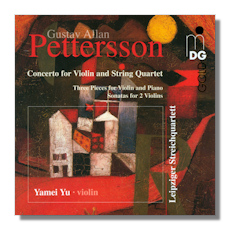
The Internet's Premier Classical Music Source
Related Links
- Pettersson Reviews
- Latest Reviews
- More Reviews
-
By Composer
-
Collections
DVD & Blu-ray
Books
Concert Reviews
Articles/Interviews
Software
Audio
Search Amazon
Recommended Links
Site News
 CD Review
CD Review
Gustav Allan Pettersson

- Concerto for Violin & String Quartet
- Two Élégies for Violin & Piano
- Romance for Violin & Piano
- Andante espressivo for Violin & Piano
- Sonata #2 for 2 Violins
- Sonata #3 for 2 Violins
- Sonata #7 for 2 Violins
Yamei Yu, violin
Andreas Seidel, violin
Chia Chou, piano
Leipzig String Quartet
Dabringhaus & Grimm MDG3071528-2 56m
Allan Pettersson (1911-1980) is mainly known as a composer of a broad symphonic oeuvre. The First and Seventeenth were, for some unknown reason, left incomplete, but the other fifteen are, what one may consider, the testament of Pettersson's tormented life. Written over four decades (1951-1980), these works contain some supremely dramatic music, and each one has its own particular timbre.
Chronologically as well as in terms of their instrumental forces, the Concerto (1949) and the seven Sonatas for two violins (1951) are linked with this symphonic language. Moreover, they were composed in the years after he relinquished his post as violist with the Concert Society Orchestra of Stockholm, thus finding more time for composition. Radically condensed in their motivic material, these pieces convey the composer's inner conflicts with telling effect, and the tension is unrelenting.
The Violin Concerto is crammed with dissonances, and in the composer's words, his objective was to project a picture of his childhood suffering, when he had to absorb the pain of the poor, broken and sick people, and worst of all – the oppressed.
The Two Élégies (1934), Andante espressivo (1938) and Romanza (1942) are prime examples of Pettersson's rapidly developed technical ability and formal language, but all three exhibit a tinge of melancholy that would characterize his entire output, although the Andante's impressionistic tone and the Romance's polyphonic element gives them a slightly softer touch than the Élégies' dark mood.
This is difficult and challenging music of the first order but the intensity and depth of feeling that Pettersson pours out have a hypnotic power that draws the listener into the thick of the argument. Performances are persuasive throughout and the whole team is passionately committed to Pettersson's cause. The Concerto in particular is an electrifying experience. First rate sound notes and presentation complete a fine MD&G issue dedicated to one of Sweden's greatest 20th century composers.
Copyright © 2011, Gerald Fenech





















